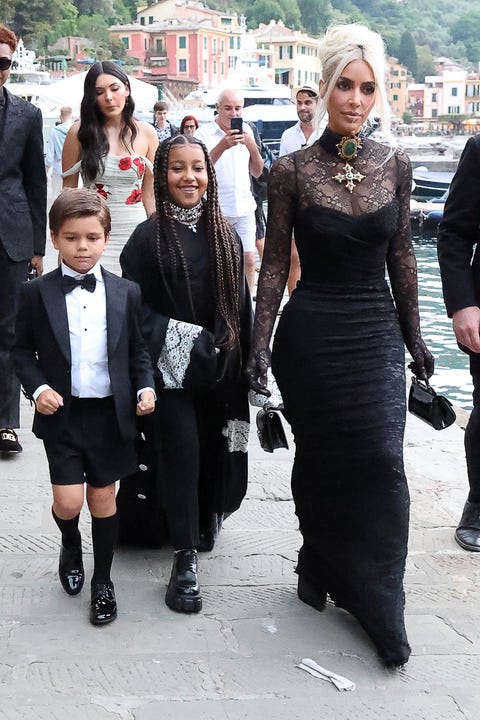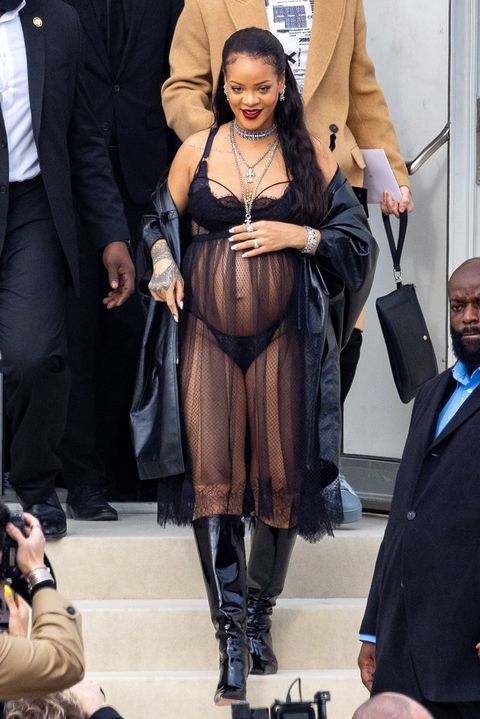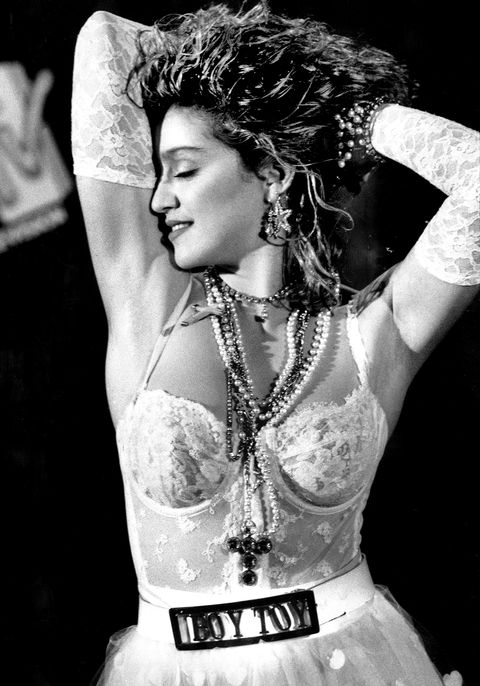
The Kardashians & the Cross: Jewelry Trend or Sacrilege?
Given where we are in the culture these days, it shouldn’t have come as a surprise to anyone that the latest Kardashian extravaganza—by which we’re referring to eldest sister Kourtney and Blink-182 drummer Travis Barker’s third wedding celebration in Portofino a few weekends ago—was essentially a multi-day branded blitz sponsored by Dolce & Gabbana. What did raise a few eyebrows, though—not to mention light up the Twitterverse—was the entire Klan’s unfettered embrace of Catholic motifs and cross jewelry, namely of the oversized, ornate, Gothic costume variety. (There is also the matter of the bride’s look: a teeny micro-dress topped off with a veil embroidered with an image of the Virgin Mary. Make of that what you will.)
With Rihanna’s internet-breaking pregnancy reveal still fresh—you surely remember that pink Chanel coat with its Gripoix buttons, a giant, multicolored vintage Christian Lacroix cross dangling over her bare belly—we couldn’t help but wonder: are crosses the new chains?
More importantly, have they transcended their religious connotations so that anyone, Christian or otherwise, can wear them now? (Let us clarify that members of the Kardashian family have alluded to their Christian faith in the past; Barker was raised Catholic.) “I don’t think that’s possible,” says Frank Everett, senior vice president of Sotheby’s Jewelry. “Outside of the high fashion world, the overwhelming majority of cross necklaces are worn by Catholics or Christians.” And that includes several notable—and very expensive—gems that the auction house has sold in recent years, from an extremely rare Byzantine-inspired pearl, turquoise, amethyst, and gold beaut designed by Robert Goossens for Chanel to an antique reliquary-pendant studded with rose-cut diamonds.
There is the issue of appropriation, too. “If you’re a non-Christian and you’re wearing a cross for fashion, I don’t see a big difference there between that and somebody wearing the garb of any other culture that is not theirs,” he says. “There should be a reverence and a respect for religious symbols of all kinds.”
Lisa Jackson takes a slightly different, maybe more forgiving, view. The jewelry designer, who used to have an entire line, called LJ Cross, devoted to the motif, cites the ’80s as a major turning point. “With the emergence of Madonna, Prince, and George Michael, the cross took a new shape. Everything shifted—it gained an edge with the juxtaposition of religion and rebellion,” she says.
And much like the talismans people turn to when times are uncertain, crosses can bear a broader divine significance. “Yes, their roots stem from religion but that has acted as an access point for other forms of inspiration,” Jackson says. “They lend themselves to creating a sense of deep connection and spirituality while also tapping into a bit of edge or rock and roll. Small and delicate or big and expressive, to me it’s about the person wearing it. If they have a connection and own it then it’s magic.”
Prince Dimitri, jewelry designer and member of the Royal House of Yugoslavia, is diplomatic. “Some people find it offensive but it depends how it is worn and by whom,” he says, while conceding that crosses are mostly still reserved for believers. “I remember years ago the Pope declared it was disrespectful to wear crosses as a fashion accessory. People might wear them for non-religious use but in general it’s only Christians who do, so I suppose there must be some kind of double purpose here, maybe a subconscious religious attraction?” Take Elizabeth I: As determined as she was to establish a Protestant church upon inheriting the throne from her very Catholic half-sister Mary I, the Virgin Queen was tolerant of Catholicism during the early years of her reign and even kept some of its symbols.
As for the Kardashian effect? While this wedding delivered an excellent return on investment for Dolce & Gabbana—to the tune of $25.4 million, to be exact—could a boost be expected of cross jewelry sales, too? The opinion on this is unanimous: the answer is no. “They’re late to the game,” Everett says. There has always been—and will always be—a strong market for these jewels.
Prince Dimitri himself has been designing crosses for years, as evidenced by his collections and his book, Once Upon a Diamond, in which he charts the history of his family’s royal jewels. He references the ubiquity of the emblem throughout history, from the Middle Ages to the Renaissance to the Victorian era and beyond. “Just look at the marvelous cross jewelry of Fabergé and French jewelers, and later on of Chanel, Lacroix, and Saint Laurent,” he says. “I don’t think this is anything new.” Which all perhaps goes to show that the truly serious jewelry collector—like actually devout Christians—could really care less what the Kardashians are doing.
This content is created and maintained by a third party, and imported onto this page to help users provide their email addresses. You may be able to find more information about this and similar content at piano.io




